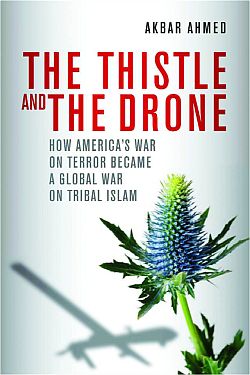The Washington Post reports:
Despite repeatedly denouncing the CIA’s drone campaign, top officials in Pakistan’s government have for years secretly endorsed the program and routinely received classified briefings on strikes and casualty counts, according to top-secret CIA documents and Pakistani diplomatic memos obtained by The Washington Post.
The files describe dozens of drone attacks in Pakistan’s tribal region and include maps as well as before-and-after aerial photos of targeted compounds over a four-year stretch from late 2007 to late 2011 in which the campaign intensified dramatically.
Markings on the documents indicate that many of them were prepared by the CIA’s Counterterrorism Center specifically to be shared with Pakistan’s government. They tout the success of strikes that killed dozens of alleged al-Qaeda operatives and assert repeatedly that no civilians were harmed.
It’s easy to conjure an image of reporters Bob Woodward and Greg Miller studying these documents and their markings, amazed at the trove of information they stumbled upon. But who are they kidding?
The key word in the opening sentence of their report is “obtained.”
I have a hunch these documents weren’t obtained while rummaging through dumpsters behind the some State Department offices. Neither do I imagine were they were handed to Woodward in a dimly lit parking garage by an anonymous source. Neither do I believe a new whistle-blower is involved.
If the reporting was more honest it would not evoke an aura of mystery by using this shadowy expression, obtained. It would instead refer to memos provided to the Washington Post.
As gifts rather than a discovery, the key questions are who provided the memos and what was the source’s objective?
With Bob Woodward’s name in the byline, it’s reasonable to assume that this is a case of an official leak in exchange for services rendered.
The principle service comes in the form of the headline: “Secret memos reveal explicit nature of U.S., Pakistan agreement on drones”
It sounds like the CIA is pushing back against Pakistani Prime Minister Nawaz Sharif’s demand that the U.S. needs to respect Pakistan’s “sovereignty and territorial integrity” and end drone strikes.
The purpose of the CIA in leaking these memos is to show that drone strikes have been conducted with the Pakistani government’s cooperation. But given the relative power of the U.S. and Pakistan, that cooperation is more like the kind the mafia earns through a protection racket.
The report later says:
In a measure of the antagonism between the two sides, a 2010 memo sent by Pakistan’s Ministry of Foreign Affairs to its embassy in Washington outlined a plan to undermine the CIA.
“Kindly find enclosed a list of 36 U.S. citizens who are [believed] to be CIA special agents and would be visiting Pakistan for some special task,” said the memo, signed by an official listed as the country’s director general for Americas. “Kindly do not repeat not issue visas to the same.”
Referring to this as a plan to undermine the CIA, is a curious choice of phrase.
The report makes no mention of an event in early 2011 that seriously ruptured U.S.-Pakistani relations, revealing the threat the CIA poses far beyond Waziristan.
Raymond Davis, a 36-year-old former special forces soldier employed by the CIA, was arrested after he shot two suspected armed robbers in Lahore.
Shortly after the killings, The Guardian reported:
Pakistani prosecutors accuse the spy of excessive force, saying he fired 10 shots and got out of his car to shoot one man twice in the back as he fled. The man’s body was found 30 feet from his motorbike.
“It went way beyond what we define as self-defence. It was not commensurate with the threat,” a senior police official involved in the case told the Guardian.
The Pakistani government is aware of Davis’s CIA status yet has kept quiet in the face of immense American pressure to free him under the Vienna convention. Last week President Barack Obama described Davis as “our diplomat” and dispatched his chief diplomatic troubleshooter, Senator John Kerry, to Islamabad. Kerry returned home empty-handed.
Many Pakistanis are outraged at the idea of an armed American rampaging through their second-largest city.
A passage in the Post’s report that seems revealing in a way that doesn’t serve the CIA’s interests is this:
[T]he documents also reveal a major shift in the CIA’s strategy in Pakistan as it broadened the campaign beyond “high-value” al-Qaeda targets and began firing missiles at gatherings of low-level fighters.
The files trace the CIA’s embrace of a controversial practice that came to be known as “signature strikes,” approving targets based on patterns of suspicious behavior detected from drone surveillance cameras and ordering strikes even when the identities of those to be killed weren’t known.
At times, the evidence seemed circumstantial.
On Jan. 14, 2010, a gathering of 17 people at a suspected Taliban training camp was struck after the men were observed conducting “assassination training, sparring, push-ups and running.” The compound was linked “by vehicle” to an al-Qaeda facility hit three years earlier.
On March 23, 2010, the CIA launched missiles at a “person of interest” in a suspected al-Qaeda compound. The man caught the agency’s attention after he had “held two in-car meetings, and swapped vehicles three times along the way.”
Other accounts describe militants targeted because of the extent of “deference” they were shown when arriving at a suspect site. A May 11, 2010, entry noted the likely deaths of 12 men who were “probably” involved in cross-border attacks against the U.S. military in Afghanistan.
Although often uncertain about the identities of its targets, the CIA expresses remarkable confidence in its accuracy, repeatedly ruling out the possibility that any civilians were killed.
One table estimates that as many as 152 “combatants” were killed and 26 were injured during the first six months of 2011. Lengthy columns with spaces to record civilian deaths or injuries contain nothing but zeroes.
Those assertions are at odds with research done by human rights organizations, including Amnesty International, which released a report this week based on investigations of nine drone strikes in Pakistan between May 2012 and July 2013. After interviewing survivors and assembling other evidence, the group concluded that at least 30 civilians had been killed in the attacks.
White House spokesman Jay Carney acknowledged Tuesday that drone strikes “have resulted in civilian casualties” but defended the program as highly precise and said there is a “wide gap” between U.S. estimates and those of independent groups.
That someone targeted by a missile strike could be described as a “person of interest” is beyond Orwellian.
In law enforcement parlance, a person of interest is someone that authorities are investigating — someone who may end up being arrested.
To catch the “interest” of the Obama administration, however, apparently means marked for killing. Maybe the expression is an abbreviation: such-and-such is a person the U.S. would be interested in eliminating. A type of person who might be described in an addendum to Obama’s kill list — on his wish list. An opportunistic target; a person of interest.
What the report makes clear is that a person of interest turns out to be someone who catches the CIA’s attention on the basis of mere suspicion. The agency forms the impression this person’s up to no good and so kills him — just to be safe.
As damning as this account might sound, we then come to what can be called the bureaucrat’s defense: the records show…
Amnesty International can issue a damning report on the civilian casualties from drone strikes, but from Obama on downwards, everyone can plead innocence. How? By citing official records which show columns of zeros when it comes to civilians killed or injured.
Mistakes, there may have been a few, but every strike was launched on good faith by an honest American, serving this nation and blessed by God.



